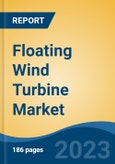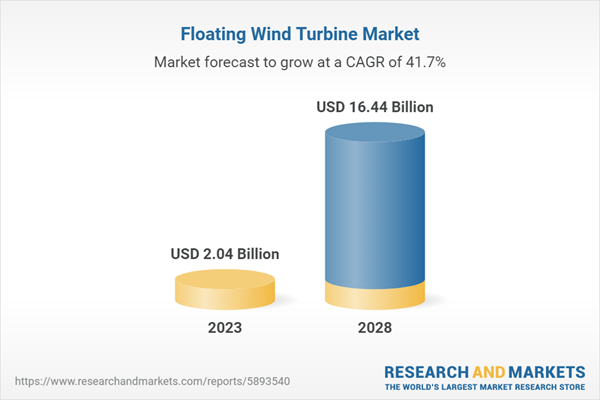Free Webex Call
The Global Floating Wind Turbine Market is expected to grow at a robust pace in the forecast period 2024-2028, owing to the significant increase in demand for renewable energy sources. Floating Wind Turbines are also affordable and have lower carbon emissions. Additionally, the floating wind turbine technology does away with the water depth restrictions, making it easier to choose the ideal location for power generation. These factors are expected to drive the global floating wind turbine market. Speak directly to the analyst to clarify any post sales queries you may have.
10% Free customizationThis report comes with 10% free customization, enabling you to add data that meets your specific business needs.
Floating Wind Turbine is a source of clean, renewable energy source that is acquired by harnessing the force of wind offshore, where the absence of impediments allows the wind to travel at a higher and more steady speed. It is one of the renewable sources that would be essential to the decarbonization process due to its great potential and strategic added value on both a socioeconomic and environmental level.
Offshore floating wind offers new possibilities and alternatives because it relies on floating rather than permanent structures. The potential minimal environmental effect and ease of production and installation of floating offshore wind are two benefits. The floating turbines and platforms can be produced and installed on land and then towed to the offshore installation location. Additionally, they can benefit from the powerful winds that are blowing in the deeper regions, which increases energy efficiency.
Increasing Shift Towards Clean Energy Generation to drive the Global Floating Wind Turbine Market
The use of renewable energy sources is a response by emerging and impoverished nations to rising carbon emissions caused by increased power demand. The development of wind farms is a result of the greater dominance of renewable energy sources like solar and wind in lowering carbon emissions. Offshore wind farms now exist as a result of advancement and technical research. Therefore, the market for floating wind farms has been driven by renewable energy sources.Moreover, according to the International Renewable Energy Agency (IRENA), renewable energy sources would provide 90% of the world's electricity by 2050. Additionally, more than 80% of the energy produced worldwide is still derived from fossil fuels, although cleaner energy sources are gaining popularity. According to the International Energy Agency (IEA), till 2022, renewable energy sources accounted for about 29% of electricity. Moreover, consumer demand for carbon-neutral electricity has sparked technological advancement and a solid supply chain as the energy vision for the future. The above factors are expected to boost the global floating wind turbine market.
Operative Advantage of Floating Wind over Fixed Offshore Structure is Driving the Growth of Global Floating Wind Turbine Market
Unlike onshore wind farms, floating wind farms don’t require land for installation. Bird deaths are decreased by floating turbines, as they may more readily avoid migratory flight lines and breeding and feeding sites. Desalination of seawater, decarbonizing energy-intensive extraction sectors, and electrolysis to produce clean hydrogen fuel, are a few examples of fuel, added to maintain environmental balance. With the highest wind flow, floating wind farms can resist challenging meteorological conditions, thus driving the growth of global floating wind turbine market.Rise in Demand for Electricity Consumption is Expected to Drive the Global Floating Wind Turbine Market
The demand for electricity has tremendously increased in recent years. Advancements in technology have led to the introduction of electronic products for domestic and commercial purposes that need electricity. Moreover, increase in per capita disposable income and spending abilities of consumers boost the sales of electronic devices such as refrigerators, televisions, and air conditioners. Furthermore, the increase in modernization coupled with growth of the construction industry and evolution of prosperous societies & residential buildings, have fueled the demand for power since the past few years. Development of commercial sector, including schools, hospitals, retail & grocery stores, office buildings, along with the rise in number of industrial deployments, has further fueled the demand for electricity. The demand for an efficient electricity supply has increased due to these factors. Thus, governments of various countries have focused on producing electricity from renewable sources, which, in turn, is expected to propel the demand for floating wind turbines. Increase in electricity production and consumption is further expected to increase in future due to rapid development in emerging economies. Thus, the impact of the above factors on the overall market is expected to drive the global floating wind turbine market during the forecast period.High Capital Investments are Expected to Hinder the Growth of Global Floating Wind Turbine Market
The market growth of floating wind power may be constrained by large initial expenditure factor. Power cables that transport electricity back onshore must be installed and maintained, which can be expensive. In water deeper than 200 feet (60m), it is challenging to build a strong and secure wind farm. These issues are beginning to be solved by floating wind turbines. Moreover, wind turbines can sustain damage from wave action, strong storms, and hurricanes. The initial expense of pre-development of wind farms, legal approval, technical considerations, engineering activities, and comparable other criteria serve as further roadblocks to the development of floating wind turbines.Thus, above factors are expected to cause hindrance to the growth of global floating wind turbine market.
Market Segmentation
The Global Floating Wind Turbine Market is segmented based on foundation, capacity, depth, and region. Based on foundation, the market is divided into spar-buoy foundation, tension-leg platform (tlp) foundation, semi-submersible foundation, and others. Based on capacity, the market is fragmented into up to 1 mw, 1-3 mw, 3-5 mw, and above 5mw. Based on depth, the market is divided into shallow water, and deep water. Based on region, the market is further segmented into North America, Asia-Pacific, Europe, South America, and Middle East & Africa.Market players
The main market players in the Global Floating Wind Turbine Market are Siemens Gamesa Renewable Energy S.A., MHI Vestas Offshore Wind A/S, ABB Group, General Electric Company (GE), Nordex SE, Goldwind Science & Technology Co., Ltd, Envision Energy Ltd, Ming Yang Smart Energy Group Co., Ltd., Hitachi Group, Suzlon Energy Ltd.Report Scope:
In this report, Global Floating Wind Turbine Market has been segmented into the following categories, in addition to the industry trends which have also been detailed below:Floating Wind Turbine Market, By Foundation:
- Spar-buoy Foundation
- Tension-Leg Platform (TLP) Foundation
- Semi-Submersible Foundation
- Others
Floating Wind Turbine Market, By Capacity:
- Up to 1 MW
- 1-3 MW
- 3-5 MW
- Above 5MW
Floating Wind Turbine Market, By Depth:
- Shallow Water
- Deep Water
Floating Wind Turbine Market, By Region:
- North America
- United States
- Canada
- Mexico
- Asia-Pacific
- India
- Japan
- South Korea
- Australia
- China
- Europe
- Germany
- United Kingdom
- France
- Italy
- Spain
- South America
- Brazil
- Argentina
- Colombia
- Middle East
- Saudi Arabia
- South Africa
- UAE
Competitive Landscape
Company Profiles: Detailed analysis of the major companies present in the Global Floating Wind Turbine Market.Available Customizations:
Global Floating Wind Turbine Market report with the given market data, the publisher offers customizations according to a company's specific needs.This product will be delivered within 1-3 business days.
Table of Contents
1. Product Overview
2. Research Methodology
5. Global Floating Wind Turbine Market
6. North America Floating Wind Turbine Market Outlook
7. Asia-Pacific Floating Wind Turbine Market Outlook
8. Europe Floating Wind Turbine Market Outlook
9. South America Floating Wind Turbine Market Outlook
10. Middle East & Africa Floating Wind Turbine Market Outlook
11. Market Dynamics
13. Company Profiles
15. About the Publisher & Disclaimer
Companies Mentioned
- Siemens Gamesa Renewable Energy S.A.
- MHI Vestas Offshore Wind A/S
- ABB Group
- Nordex SE
- Goldwind Science & Technology Co., Ltd
- Envision Energy Ltd
- Ming Yang Smart Energy Group Co., Ltd.
- Hitachi Group
- Suzlon Energy Ltd.
Table Information
| Report Attribute | Details |
|---|---|
| No. of Pages | 186 |
| Published | October 2023 |
| Forecast Period | 2023 - 2028 |
| Estimated Market Value ( USD | $ 2.04 Billion |
| Forecasted Market Value ( USD | $ 16.44 Billion |
| Compound Annual Growth Rate | 41.6% |
| Regions Covered | Global |
| No. of Companies Mentioned | 9 |









